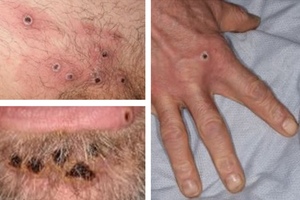
Credit UKHSA
#16,899
Six weeks ago, in Atypical Monkeypox Presentations, we looked at the `classical' presentation of Monkeypox, and reports that many recent cases being reported around the globe differed significantly from what was previously expected.
On June 7th The Lancet published the following comment which describes the atypical `. . . absence of prodromal symptoms, such as fever, malaise, and headache, and the presence of herald skin lesions at the point of sexual contact in some patients'.
Global human monkeypox outbreak: atypical presentation demanding urgent public health action
Open Access Published:June 07, 2022
And in early June the World Health Organization published an update (Link: Multi-country monkeypox outbreak: situation update), which included the following:
To date, the clinical presentation of monkeypox cases associated with this outbreak has been variable. Many cases in this outbreak are not presenting with the classically described clinical picture for monkeypox (fever, swollen lymph nodes, followed by rash concentrated on the face and extremities).Atypical features described include:
- presentation of only a few lesions or even just a single lesion;
- lesions that begin in the genital or perineal/perianal area and do not spread further;
- lesions appearing at different (asynchronous) stages of development;
- and the appearance of lesions before the onset of swollen lymph nodes, fever, malaise or other symptoms.
Viral infections typically present with a wide spectrum of clinical signs and symptoms, and as time goes on, we may discover even more diversity in the ways that Monkeypox infection can manifest in humans.
Monkeypox case definition updated to include new symptoms
In light of clinical experience during this outbreak, the UK Health Security Agency (UKHSA) is updating the case definition for monkeypox.
From:UK Health Security Agency Published 25 July 2022
The symptom list has been expanded to include a single lesion or lesions on the genitals, anus and surrounding area, lesions in the mouth, and symptoms of proctitis (anal or rectal pain or bleeding), especially if the individual has had a new sexual partner recently. This will help both individuals and clinical professionals identify monkeypox symptoms.
The majority of people with monkeypox can safely manage their symptoms at home and there have been no deaths in the UK. Most people experience mild disease but it can cause a significant illness in some, requiring hospitalisation, including for severe pain. If you think you have monkeypox, stay at home and contact 111 or your local sexual health service for advice.
Meera Chand, Director of Clinical and Emerging Infections at UKHSA, said:
We continue to see new diagnoses of monkeypox, passed on primarily through close or sexual contact.
We have updated our case definitions to reflect the clinical presentations that have been seen during this outbreak. It is important to recognise that just one or two genital or anal lesions, or lesions in the mouth can be signs of monkeypox, especially if you have had a new sexual partner.
There is still a need to be cautious, stay alert for symptoms and call a sexual health clinic if you think you may have monkeypox. For many people symptoms can be mild but for some people, hospital treatment may be required.
Guidance and materials are being updated to reflect the new case definition and expanded symptoms list.